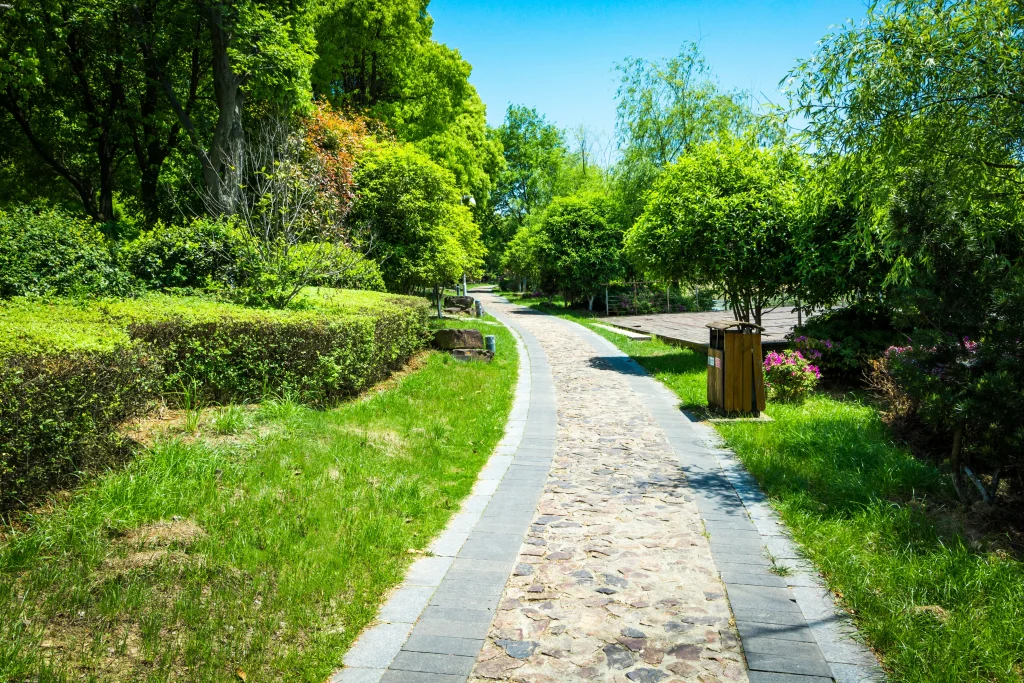Transforming your yard into a stunning desert oasis doesn’t mean sacrificing beauty for sustainability. With the right combination of rocks, native plants, and thoughtful design, you can create a low-maintenance, water-efficient landscape that thrives in Denver’s dry climate.
In this guide, we’ll explore 18 creative rock desert landscape ideas and show you how to balance aesthetics, function, and eco-friendly design.
What is a rock desert landscape?
A rock desert landscape is a water-efficient landscaping approach that combines natural rock elements, gravel, and drought-tolerant plants to create beautiful, sustainable outdoor spaces adapted to arid climates.
The foundation includes 3 core components:
- Decorative stone materials (boulders, river rock, crushed gravel) that provide structure and visual interest.
- Carefully selected drought-resistant plants that thrive with minimal water.
- Efficient ground coverage that suppresses weeds and maintains aesthetic appeal.
This design method works well in Denver’s environment where traditional lawns struggle.
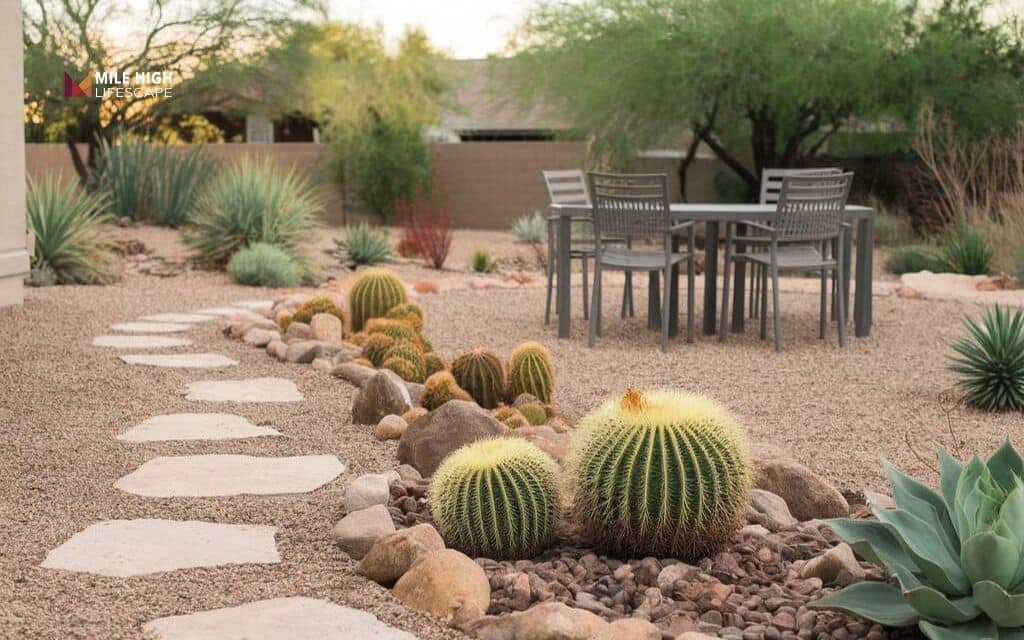
Benefits of rock desert landscaping
Water conservation
Rock desert landscapes reduce outdoor water consumption by 60 to 80 percent compared to traditional grass lawns. For an average property, this translates to saving approximately 25,000 gallons annually.
Reduced maintenance and costs
Say goodbye to weekly mowing, fertilizing, and reseeding. Rock desert landscapes require minimal upkeep like debris removal, pruning, and periodic irrigation checks replace the constant demands of lawn care. This reduction helps eliminate ongoing costs (lawn equipment, fuel, fertilizers).
Property value
Beyond immediate savings, professionally designed rock desert landscapes can boost property values by 10% to 15% as water-conscious buyers increasingly seek homes with sustainable landscaping features.
Practical environmental benefits
Rock and gravel coverage reduces weed growth by eliminating bare soil where unwanted plants establish. The strategic placement of stone materials prevents soil erosion during Colorado’s intense thunderstorms and spring runoff.
Native plants integrated into rock gardens provide essential habitat for pollinators including native bees, butterflies, and hummingbirds, while diverse plant structures offer food and shelter for beneficial insects and songbirds.
How to design a rock desert landscape
Choose the right rocks for your yard
Success begins with understanding different rock types and their best applications:
- Decomposed granite provides versatile, compactable material ideal for pathways and ground cover. Its fine texture and warm tones blend naturally with plantings while allowing water penetration and suppressing weeds.
- River rock brings smooth, rounded stones in various sizes that excel at moisture retention around plant roots and create pleasing textural contrast. Use it in dry creek beds, as decorative mulch, or in areas wanting softer visual appeal.
- Lava rock offers lightweight volcanic stone with reddish-brown hues. Its porous structure provides drainage, and bold colors create dramatic focal points.
- Crushed gravel delivers durability for functional spaces like driveways and high-traffic pathways. The angular stones compact firmly and lock together, creating stable surfaces that resist displacement.
- Boulders serve as sculptural anchors, providing vertical interest and natural-looking focal points. Position them partially buried and grouped in odd numbers for the most authentic appearance.
Combine native plants with rock features
Select drought-tolerant plants adapted to Denver’s climate:
- Blue grama grass provides soft ground cover with a fine texture and minimal water needs.
- Yucca brings a bold, structural presence with sword-like evergreen leaves.
- Agave species offer sculptural beauty perfect for sunny locations.
- Russian sage contributes airy texture and lavender-blue flowers from midsummer through fall.
- Penstemon delivers vibrant tubular flowers that attract hummingbirds.
- Apache plume provides multi-season interest with white flowers and feathery seed heads.
Layer plants strategically: position low-growing ground covers along edges, place mid-height perennials in secondary layers using odd-numbered clusters, and reserve taller specimens as focal points.
Incorporate smart irrigation systems
Even drought-tolerant landscapes need supplemental water during establishment and Denver’s driest periods.
- Drip irrigation delivers water directly to root zones. Position emitters at plant bases and group plants with similar water needs on the same zones.
- Soaker hoses provide simpler alternatives for smaller areas, weeping water along their length for even distribution. Cover with mulch to reduce evaporation.
- Moisture sensors prevent waste by monitoring actual soil conditions rather than running on fixed schedules.
- Programmable timers allow scheduling during optimal periods (early morning when evaporation is lowest), while smart controllers adjust watering based on weather data and real-time conditions.
18 rock desert landscape ideas to inspire you
Modern minimalist desert front yard
Design rock beds in strong geometric shapes – rectangles or angular patterns that echo your home’s architecture. Fill these spaces with gravel in neutral tones like gray or charcoal.
Plant succulents such as hens-and-chicks and sedums in repeating patterns for orderly visual rhythm. Incorporate concrete pavers or cut flagstone in precise arrangements. Keep plantings minimal, selecting just 3 to 5 species repeated throughout.
See related: 10 modern black rock landscape ideas for Denver homes
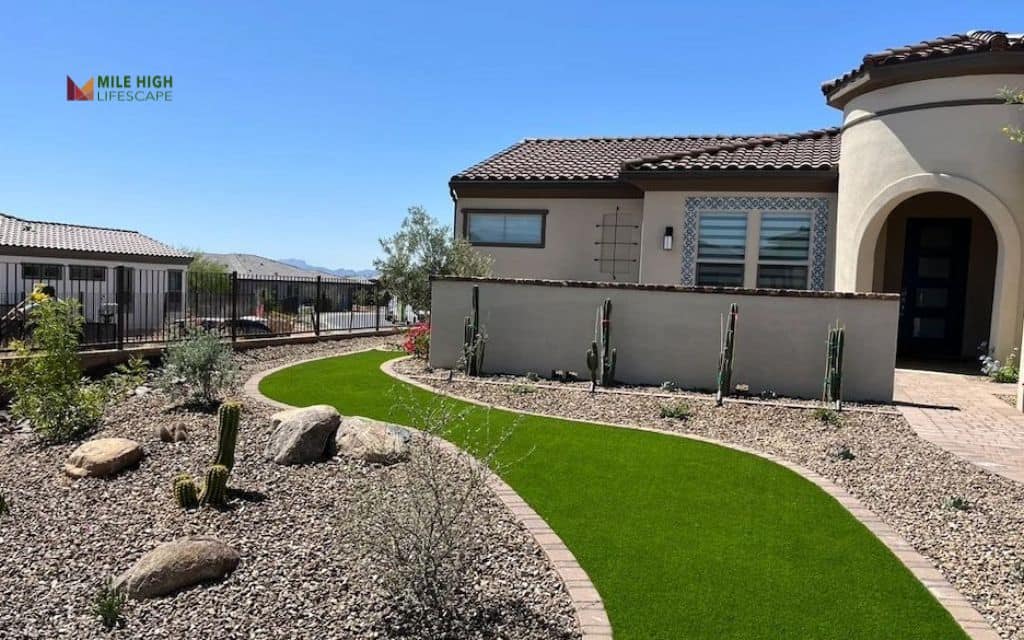
Southwest-inspired courtyard
Use decomposed granite in warm rust or amber tones as primary ground cover. Border planting beds with rustic flagstone or stacked sandstone walls that echo adobe architecture.
Plant cold-hardy cacti including prickly pear and barrel cactus as sculptural focal points. Add wrought iron accents or terra cotta elements to reinforce the theme.
Use river rock in warm browns and reds for dry stream beds or decorative borders. String bistro lights overhead for evening ambiance, creating an enchanting outdoor retreat.

River rock pathway with native grasses
Create smooth, organic pathways using river rock in three-quarter to one-and-a-half-inch sizes for comfortable walking surfaces.
Edge pathways with larger cobbles or small boulders to prevent rock migration. Flank paths with ornamental native grasses like sideoats grama, little bluestem, and prairie dropseed.
The flowing forms of grasses create stunning contrast against rounded river rock. As grasses sway in Denver’s breezes, they animate the landscape while pathways provide reliable access.
See related: 21 landscape designs with river rock that transform ordinary yards into water-wise retreats
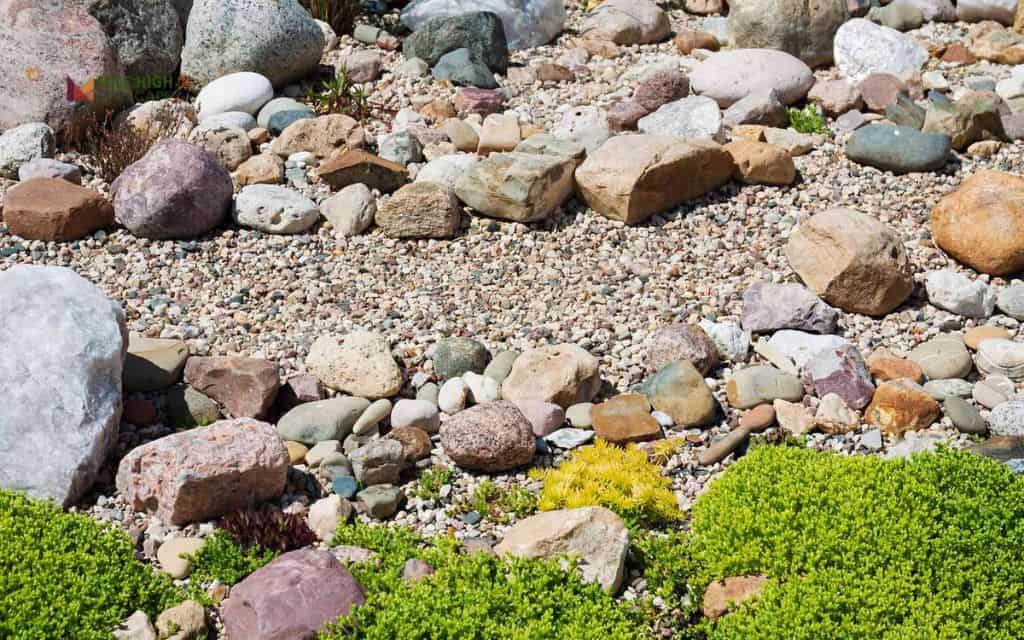
Cactus & agave feature bed
Create focal points with architectural cacti and agaves. Select sunny locations with excellent drainage. Mix additional sand or gravel into soil to ensure rapid drainage. Choose cold-hardy species like plains prickly pear, mountain ball cactus, and claret cup cactus.
Pair with cold-tolerant agaves such as Agave parryi, positioning them as anchors. Surround plantings with gravel that reflects light and accentuates plant forms. Add substantial boulders for scale and natural-looking groupings. This creates living sculpture with seasonal interest.
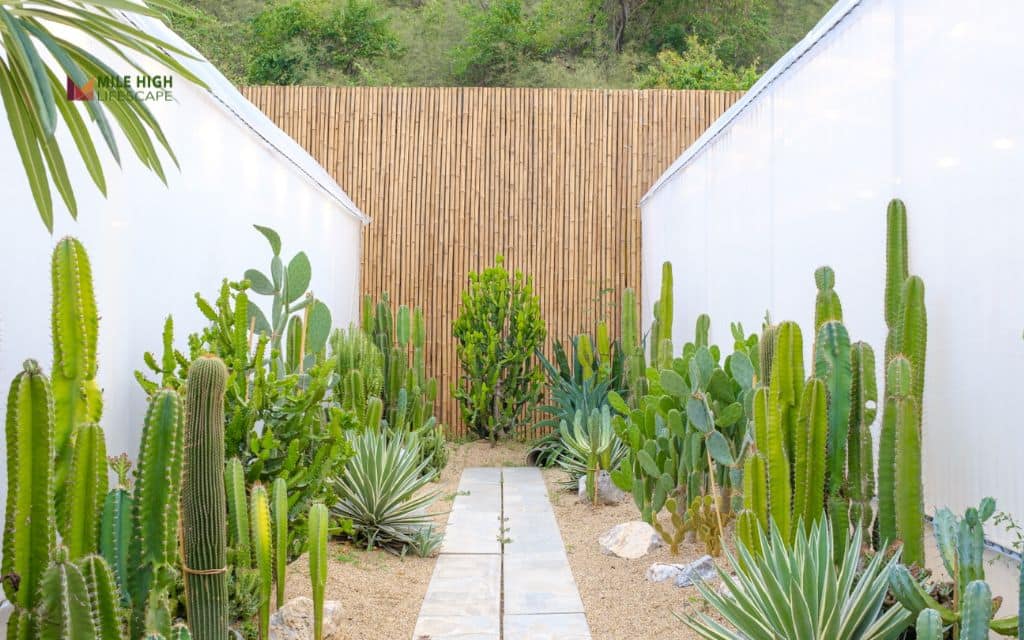
Gravel lawn alternative
Replace turf with gravel that provides open space without irrigation or mowing. Select gravel in quarter-inch to three-eighths-inch size for a refined surface. Install landscape fabric beneath to suppress weeds while allowing water infiltration. Edge the area with brick, steel, or stone for crisp boundaries. This approach provides clean, maintained appearance while using minimal water and requiring only occasional raking.
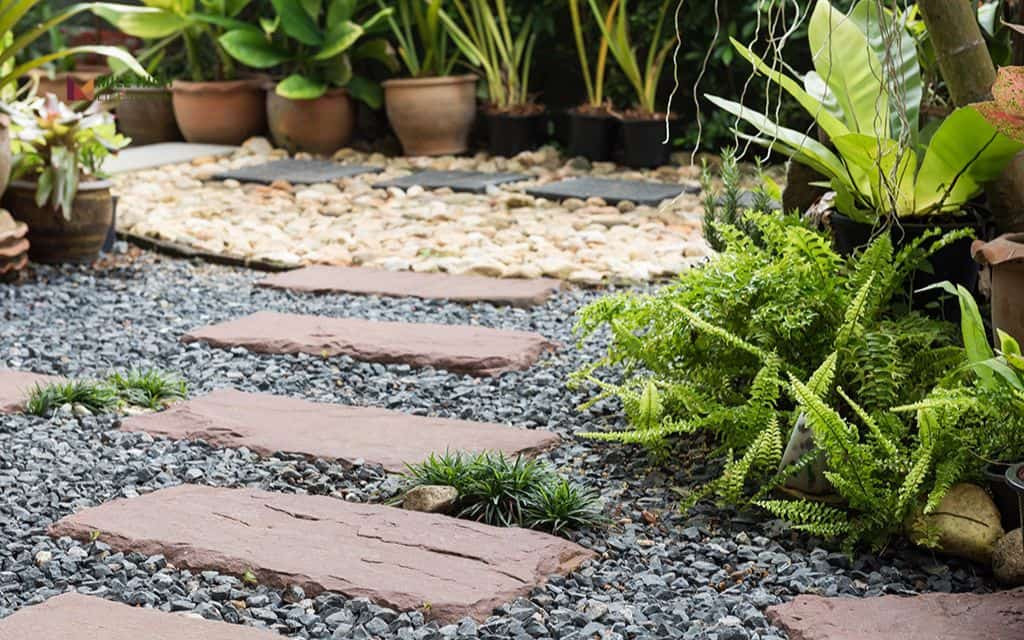
Boulder-focused xeriscape
Use large boulders as anchors providing structure and permanence. Select 3 to 5 major boulders in varying sizes, positioning them naturally.
Plant around boulders with natives that enhance rather than compete. Use low-growing plants like penstemon immediately adjacent, allowing them to cascade around stone bases.
Position taller specimens like apache plume several feet away where they frame the rocks. Fill spaces with crushed gravel or decomposed granite.
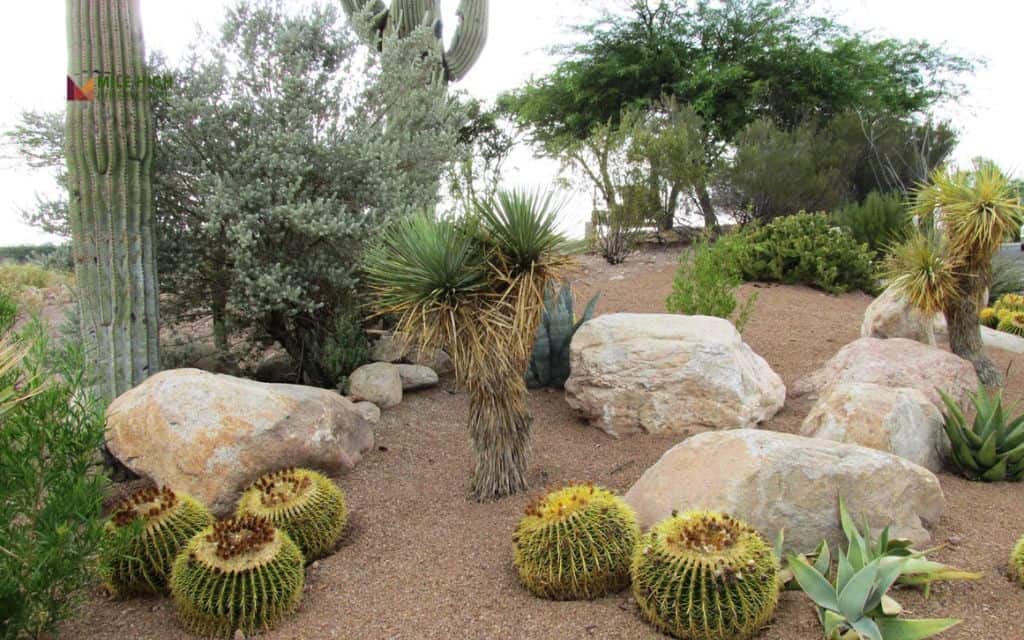
Dry creek bed for drainage control
Solve drainage challenges while adding naturalistic beauty. Design creek beds to follow natural drainage patterns, creating channels that direct water away from structures. Excavate channels four to eight inches deep and eight to twenty-four inches wide depending on water volume.
Line with river rock in varying sizes – larger cobbles along edges and center, medium stones filling the main bed. Plant banks with native grasses and perennials that tolerate wet and dry conditions, such as prairie dropseed and goldenrod.
During storms, the creek springs to life with water, then returns to an attractive stone feature.
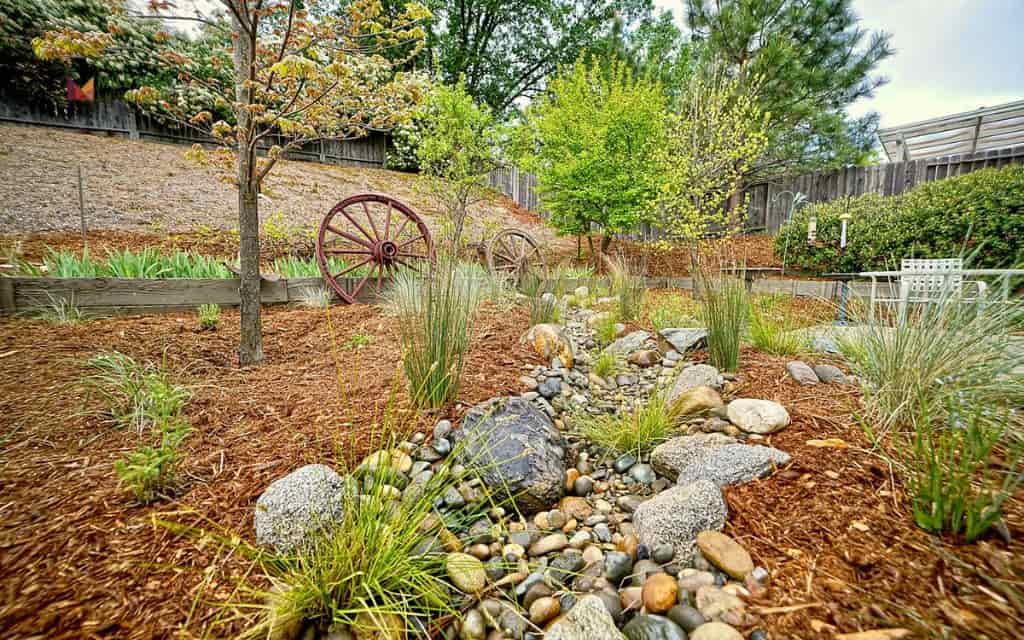
Rock garden with pollinator plants
Support beneficial insects by integrating pollinator-friendly plants throughout rock gardens. Use rocks and gravel as foundation, then plant with native flowering perennials. Include penstemon species for hummingbirds, purple coneflower for nectar and bird seeds, and bee balm for native bees.
See related: 20 simple rock landscaping ideas for Denver lawns with low maintenance needs
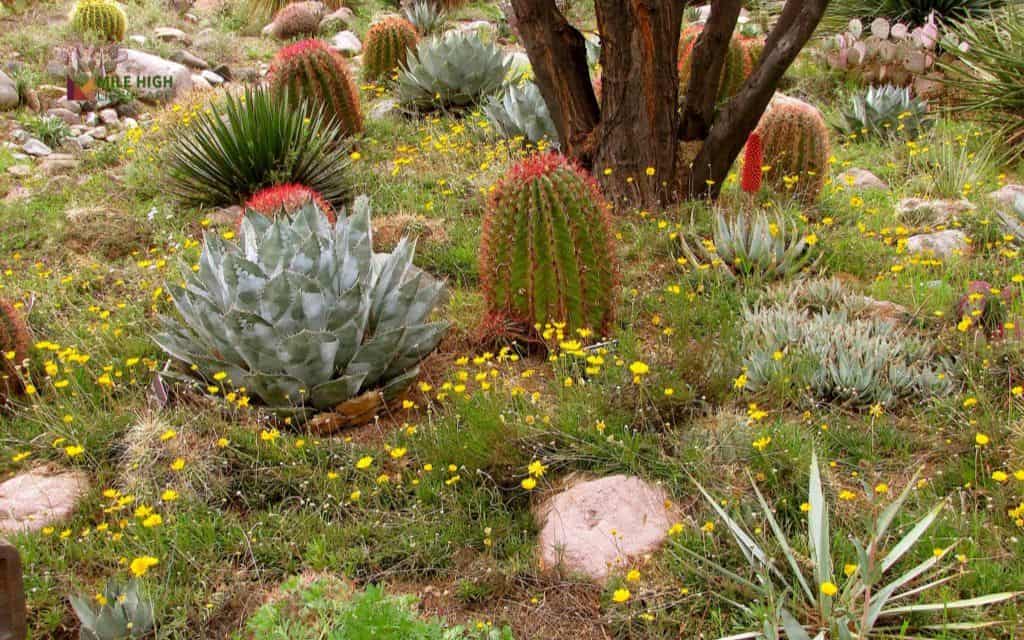
Terraced desert hillside
Transform slopes into multi-level gardens through terracing that controls erosion. Build retaining walls from stacked stone, concrete block, or timber to create level terraces. Keep individual heights to two to four feet for manageable construction.
Fill terraces with plants matched to sun exposure. Upper terraces receive maximum sun – ideal for cacti and yucca. Lower terraces benefit from runoff moisture – accommodating coral bells and purple coneflower. Surface each terrace with gravel or decomposed granite. Install flagstone or timber steps between levels for access.
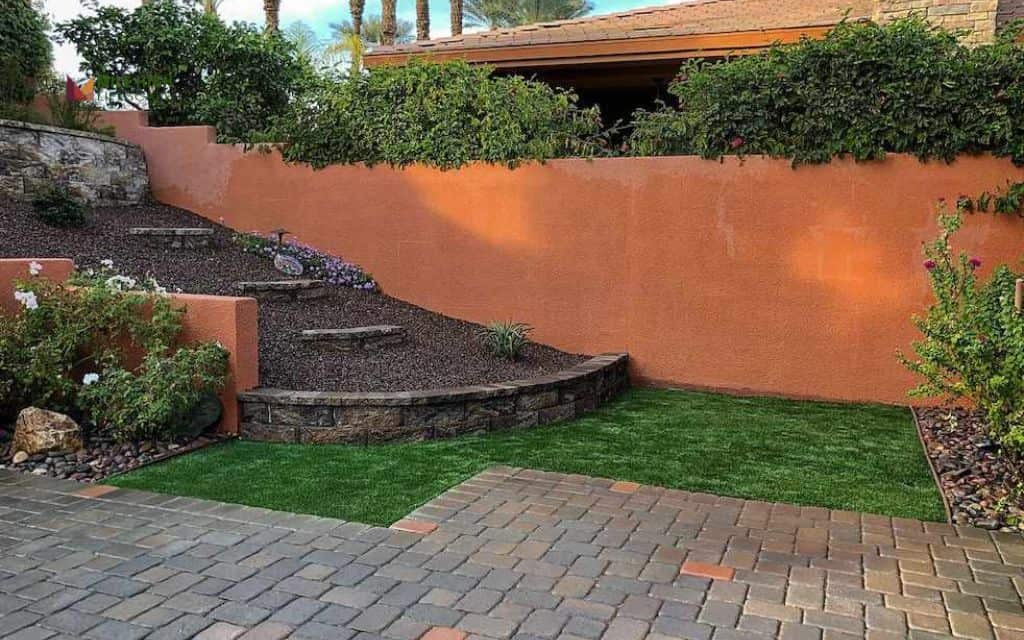
Desert zen garden
Create peaceful meditation spaces with simplicity and minimal plantings. Cover flat or gently contoured areas with fine gravel in light neutral tones. Rake the gravel in parallel lines or flowing patterns suggesting water movement. Position boulders as focal points asymmetrically.
Limit plantings to just a few specimens, perhaps a single juniper, ornamental grasses, or pruned native shrub. Restraint directs attention to rock forms and negative space. Add simple stone bench seating. This zen garden idea requires regular raking but rewards with tranquility.
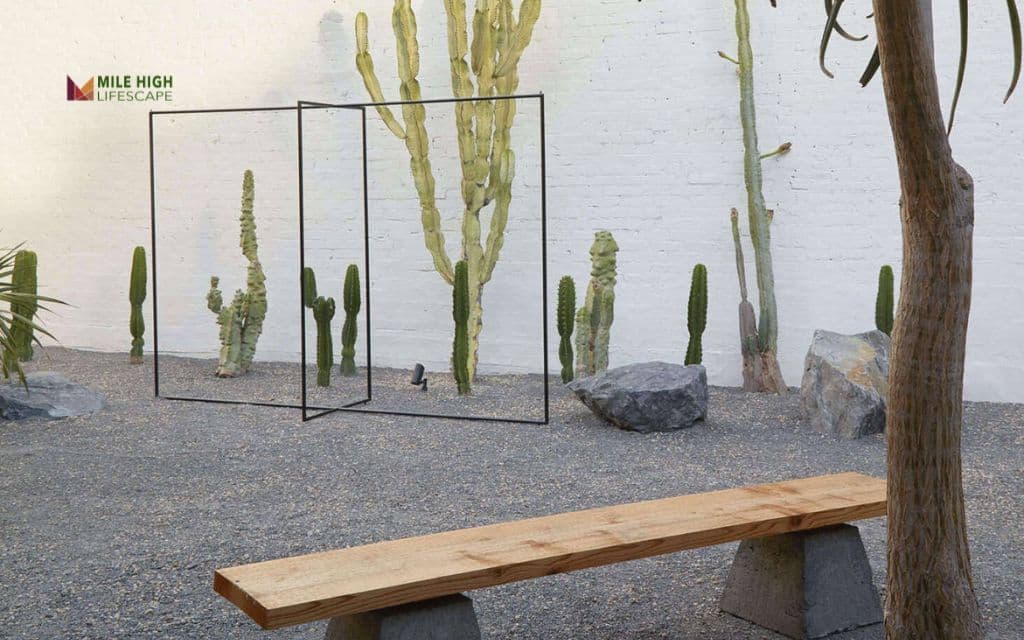
Native wildflower and stone mix
Soften rocky landscapes with generous drifts of native wildflowers that add seasonal color while maintaining drought tolerance and supporting local ecosystems. This approach creates naturalistic meadow effects within structured rock garden frameworks.
Use gravel pathways and boulder placements to provide structure, then fill the spaces between with informal wildflower plantings. Select species that reseed readily and naturalize over time, such as black-eyed Susan, blanket flower, prairie coneflower, and blue flax.
Plant in large, irregular drifts rather than orderly rows, allowing colors to intermingle and create the casual appearance of wildflower meadows.
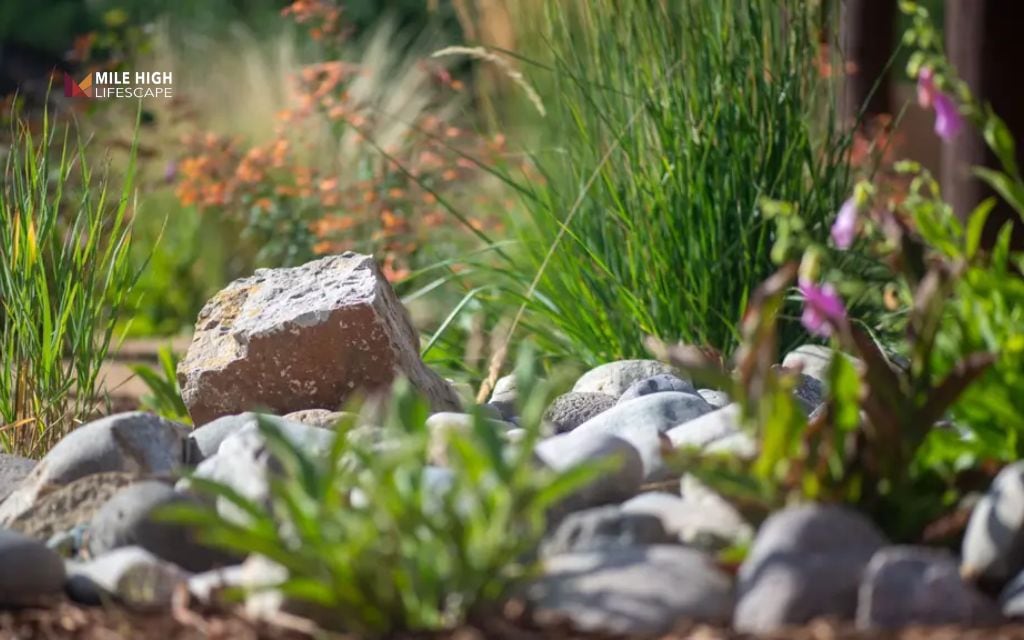
Outdoor fireplace with gravel seating zone
Position your fireplace or fire pit to serve as the focal point, constructing it from stone, brick, or concrete materials that complement your home’s architecture. Surround this central feature with crushed gravel in quarter-inch to three-eighths-inch size, which compacts into stable surfaces that support furniture and foot traffic while allowing water infiltration.
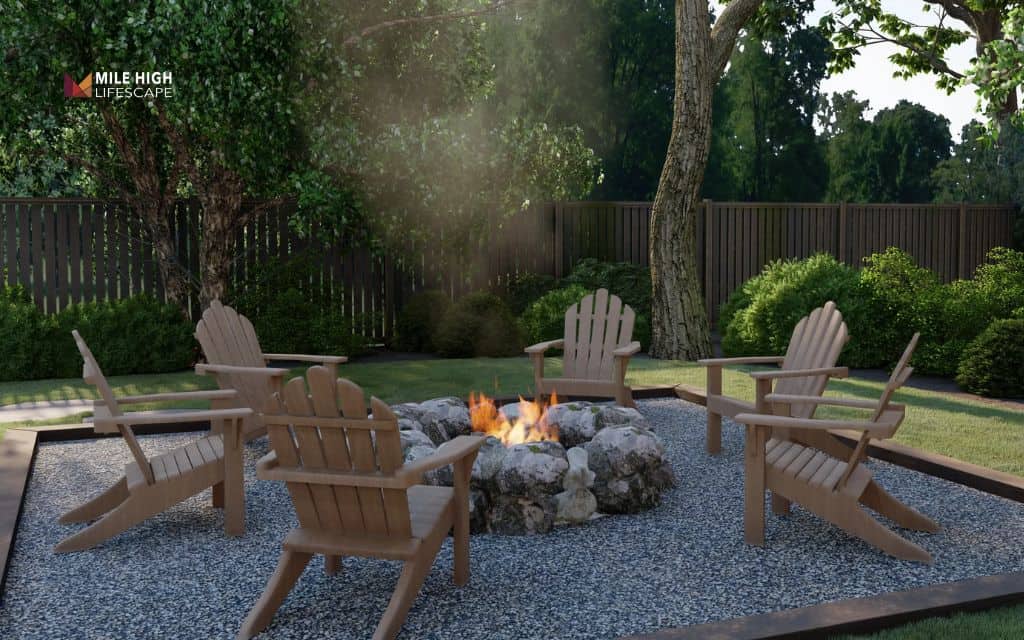
Flagstone patio with succulent borders
Natural flagstone patios provide beautiful outdoor living surfaces that pair with succulent plantings along borders and in crevices. This combination creates cohesive designs that blend hardscape functionality with living plant interest.
Lay irregular flagstone pieces in mortared or dry-set patterns for stable walking surfaces. Choose Colorado-sourced flagstone in colors complementing your home – sandstone, slate, or quartzite. Leave narrow gaps between stones for visual interest.
Border with succulent varieties: Hens-and-chicks, sedums, and ice plants,… Plant succulents in crevices between flagstones where they’ll naturalize, softening hard edges.
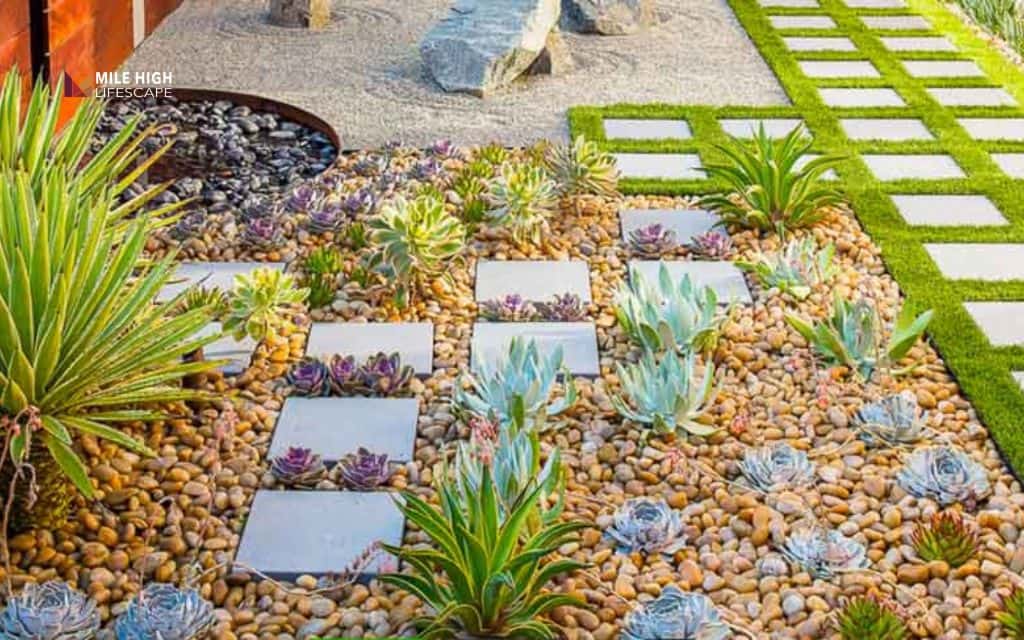
Retaining wall garden with desert blooms
Turn retaining walls into vertical gardens maximizing planting space. Construct walls with planting pockets – spaces between stones where plants establish roots. Leave strategic gaps and recesses that provide excellent drainage and allow cascading.
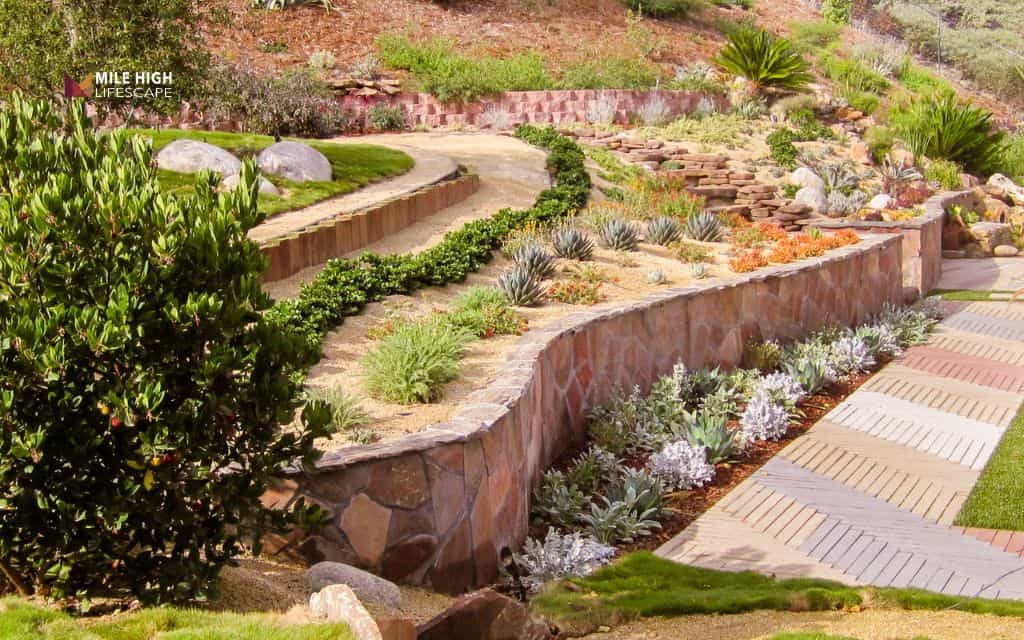
Xeriscape with decorative lava rock
Add bold color contrast with lava rock‘s distinctive reddish-brown and charcoal hues. Use as top dressing in 3 to 4-inch layers that suppress weeds and regulate temperature. The porous volcanic stone allows excellent air and water movement while weighing less than river rock.
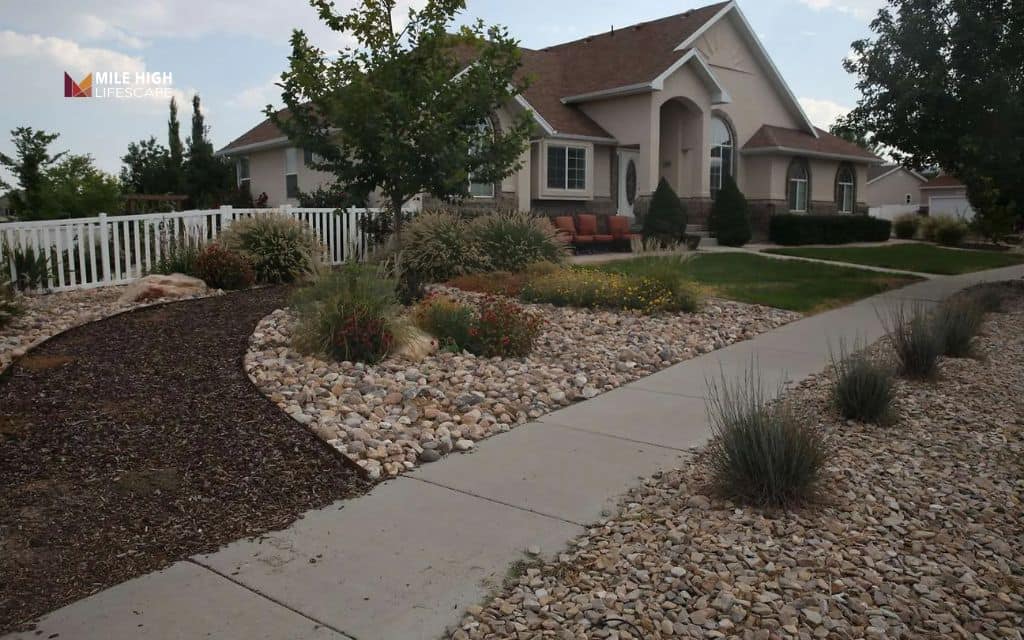
Wildlife-friendly rock garden
Support wildlife by incorporating features providing food, water, and shelter. Include shallow birdbaths, small fountains, or recirculating streams for drinking and bathing. Position near rocks or shrubs where birds feel safe. Refresh water regularly.
Plant natives supporting wildlife. Berry-producing shrubs like serviceberry feed birds. Seed-producing perennials including coneflowers provide fall and winter food. Nectar-rich flowers attract hummingbirds and native bees. Layer plantings from ground covers through shrubs creating habitat structure.
These wildlife-friendly features integrate seamlessly into attractive rock garden designs.
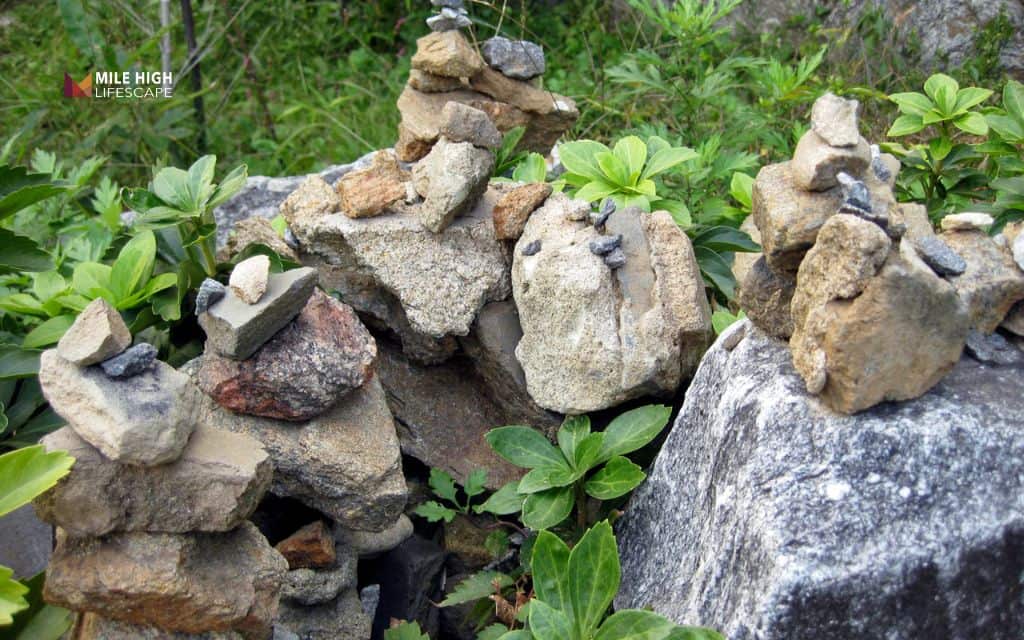
Front yard gravel mosaic design
Create eye-catching curb appeal through artistic gravel patterns combining multiple colors and textures. Plan designs inspired by geometric shapes or abstract forms. Select 2 to 4 gravel colors – tan decomposed granite with gray crushed rock and rust lava rock.
Install landscape fabric as base, then section off areas marking pattern boundaries. Fill each section with designated gravel type, compacting lightly with clean transitions. Incorporate stepping stone pathways for access.
This creative approach transforms front yards into distinctive landscapes that stand out.
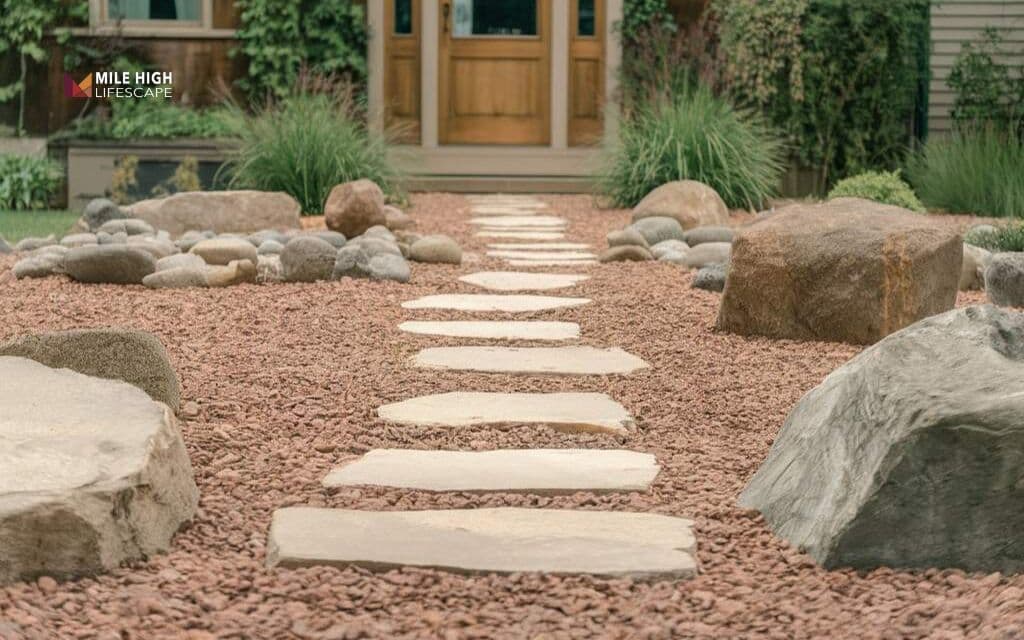
Shade-tolerant desert corner
Design shade-appropriate gardens for north-facing areas or spaces beneath trees.
Select shade-tolerant natives including Rocky Mountain juniper, creeping mahonia, coral bells, and native ferns. These thrive in reduced light while maintaining drought tolerance once established.
Use rocks and gravel as structural elements creating pathways and borders. In shade, incorporate organic mulch more liberally without moisture retention concerns.
This combination creates successful gardens in challenging shade while maintaining water conservation.

Maintenance tips for long-lasting desert landscapes
- Monthly debris removal: Blow or rake leaves, seeds, and organic matter from rock surfaces to prevent weed establishment and maintain clean appearance. Use a leaf blower for large areas or garden rake for smaller spaces.
- Bi-annual irrigation inspection: Check systems in early spring before activation and mid-summer during peak use. Inspect for damaged emitters, clogged lines, proper coverage patterns, and flush drip lines to remove mineral deposits from hard water.
- Annual plant pruning: Remove spent flower stalks, dead leaves, and damaged branches to maintain attractive shapes and promote air circulation. Cut ornamental grasses back to ground level in late winter before new growth emerges.
- Weed monitoring and removal: Rock landscapes reduce weed problems significantly, but occasional unwanted plants still appear.
- Mulch replacement every 2-3 years: Replenish organic mulch (wood chips or shredded bark) around plant roots as it decomposes to maintain moisture retention and weed suppression. Rock mulch remains permanent and doesn’t require replacement.
Conclusion
Rock desert landscaping is a smart, sustainable choice for Denver homeowners seeking beauty that lasts while conserving precious water resources. By combining local rock materials, native drought-tolerant plants, and efficient irrigation systems, you create stunning landscapes that thrive in Colorado’s semi-arid climate with minimal maintenance.
Mile High Lifescape – Your Denver Landscape Experts
For 20 years, Mile High Lifescape has specialized in creating stunning rock desert landscapes perfectly adapted to Denver’s semi-arid climate. Our landscape rock service handles everything from design to installation – xeriscape gardens, rock placement, native plantings, irrigation, and drainage solutions built for Colorado conditions.
Ready to transform your yard into a water-wise desert oasis?
Call Mile High Lifescape: (303) 877-9091
Frequently asked questions (FAQ)
How much water can a rock desert landscape save?
Rock desert landscapes typically save 60 to 80% of outdoor water compared to traditional grass lawns. For an average Denver property, this equals approximately 25,000 gallons conserved annually.
Can I mix mulch and rock in the same landscape?
Yes, combining both materials often produces the best results. Using organic mulch (wood chips or shredded bark) around plant root zones improves soil and retains moisture. Reserve rock and gravel for open areas, pathways, and sun-exposed zones where organic mulch decomposes too quickly.
How long does rock desert landscape installation take?
Professional installation typically takes 2 to 5 days for average projects, depending on complexity and site preparation. Factors affecting timeline include existing landscape removal, grading needs, irrigation installation, and hardscape elements like retaining walls or patios.
